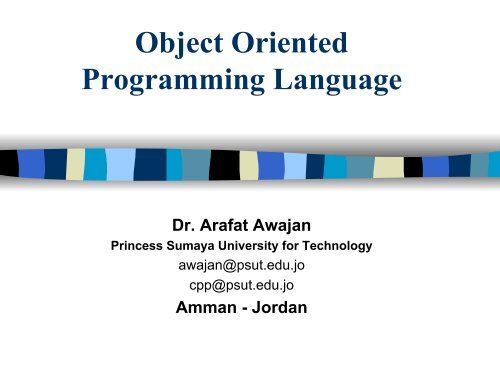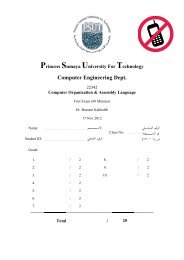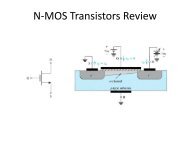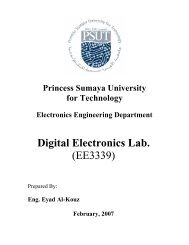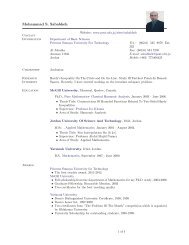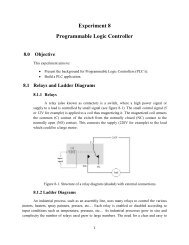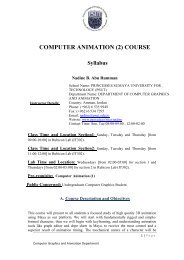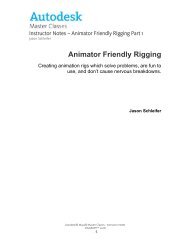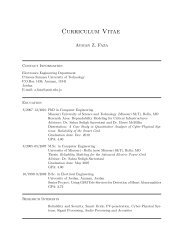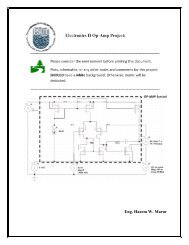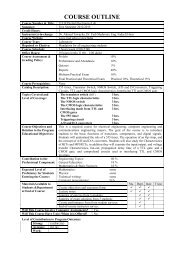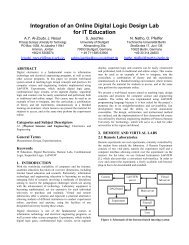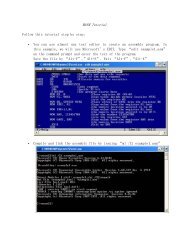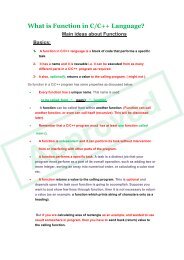C++ Programming Language - Princess Sumaya University for ...
C++ Programming Language - Princess Sumaya University for ...
C++ Programming Language - Princess Sumaya University for ...
Create successful ePaper yourself
Turn your PDF publications into a flip-book with our unique Google optimized e-Paper software.
Object Oriented<br />
<strong>Programming</strong> <strong>Language</strong><br />
Dr. Arafat Awajan<br />
<strong>Princess</strong> <strong>Sumaya</strong> <strong>University</strong> <strong>for</strong> Technology<br />
awajan@psut.edu.jo<br />
cpp@psut.edu.jo<br />
Amman - Jordan
Chapter One<br />
Introduction To OOP<br />
1. 1. <strong>Programming</strong> Concepts<br />
1. 2. Unstructured <strong>Programming</strong><br />
1. 3. Structured (Procedural) <strong>Programming</strong><br />
1. 4. Modular <strong>Programming</strong><br />
1. 5. Object Oriented <strong>Programming</strong><br />
1. 6. History of <strong>C++</strong><br />
1. 7. <strong>Programming</strong> in <strong>C++</strong><br />
1. 8. <strong>C++</strong> features<br />
1. 9. Typical <strong>C++</strong> Environment<br />
Dr. Arafat Awajan - PSUT - 2004 2
Chapter One<br />
Introduction To <strong>C++</strong><br />
1. 10. First Program<br />
1. 11. Basic elements of the language<br />
1. 12. Standard Types<br />
1. 13. Variables<br />
1. 14. Constants<br />
1. 15. Operators<br />
1. 16. Examples and Exercises<br />
Dr. Arafat Awajan - PSUT - 2004 3
1. 1. <strong>Programming</strong> Concepts<br />
a. Solving Problem:<br />
What is a problem: data + questions<br />
Solving the problem means finding the answers<br />
b. Steps of Solving Problems<br />
Analyzing the problem: input and output description<br />
Developing a solution: an algorithm<br />
Writing a program: <strong>Programming</strong> <strong>Language</strong><br />
Environment<br />
Compiling: Errors AND warning<br />
Testing<br />
Maintaining<br />
Dr. Arafat Awajan - PSUT - 2004 4
1. 1. <strong>Programming</strong> Concepts<br />
c. Evolution of programming Techniques<br />
Unstructured programming: 1950s<br />
Structured <strong>Programming</strong>: 1970s<br />
Modular <strong>Programming</strong><br />
Object Oriented <strong>Programming</strong>: 1990s<br />
d. Software requirements<br />
Time and money<br />
Per<strong>for</strong>mance and efficiency<br />
test, reuse, maintenance,<br />
OOP<br />
Dr. Arafat Awajan - PSUT - 2004 5
1. 2. Unstructured programming<br />
a. During the 1950s<br />
b. Now: the beginners<br />
c. Features<br />
The program contains only one bloc(Main)<br />
The main program directly operates on global data.<br />
Program<br />
Main + Global Data<br />
Dr. Arafat Awajan - PSUT - 2004 6
1. 3. Structured programming<br />
(Procedural)<br />
a. Research during the 1960s<br />
b. Basic idea<br />
Top Down Design divide and conquer<br />
c. Aims<br />
programs that are clearer, easier to develop,to test<br />
and to modify<br />
d. A program is a set of procedures/Functions<br />
called when needed<br />
e. <strong>Language</strong>s:<br />
Pascal (1970), C (1971), ADA (1980)<br />
Dr. Arafat Awajan - PSUT - 2004 7
Main Program<br />
Procedure<br />
Dr. Arafat Awajan - PSUT - 2004 8
1. 4. Modular programming<br />
a. Basic idea<br />
B. Example<br />
Functions / procedures with the same functionality are<br />
grouped into separate modules.<br />
Each Module can have its own data.<br />
Program<br />
Module 1 Module 2<br />
Data<br />
Data<br />
Procedure1 Procedure1 Procedure2 ..<br />
Dr. Arafat Awajan - PSUT - 2004 9
1. 5. Object Oriented programming<br />
( O O P )<br />
a. Developed during 1980s<br />
b. Aims<br />
building software quickly, correctly, and economically,<br />
more understandable, better organized, easier to<br />
maintain, modify and debug<br />
c. Definition<br />
- Objects are Independent and Reusable software<br />
components<br />
- An object is a meaningful software unit that describes<br />
data and related functions<br />
- an object models things in the real worlds<br />
Dr. Arafat Awajan - PSUT - 2004 10
1. 5. Object Oriented programming<br />
( O O P )<br />
d. Focus on objects (things)<br />
treating data and the procedures that act upon the data<br />
as a single entity - object. (encapsulation)<br />
e. Fundamental Capabilities of OOP languages:<br />
Objects(data + functions)<br />
Classes (ADT)<br />
Inheritance<br />
Polymorphism (Poly == Many, Morph == Form)<br />
f. <strong>Language</strong>s<br />
Smalltalk, <strong>C++</strong>(1985), and JAVA(1995)<br />
Dr. Arafat Awajan - PSUT - 2004 11
1. 5. Object Oriented programming<br />
( O O P )<br />
g. Examples<br />
A car is a collection of attributes: type, engine, color, size,<br />
doors, year, and so <strong>for</strong>th.<br />
A car can be described as a collection of actions: move,<br />
speed up, stop, park, and so on.<br />
Car ----> class<br />
My_Car is an object of the class car.<br />
----> The Type of My_Car<br />
----> Move My_Car<br />
----> Stop My_Car<br />
Dr. Arafat Awajan - PSUT - 2004 12
1. 5. Object Oriented programming<br />
( O O P )<br />
h. Objects<br />
They are created from a class<br />
j. Classes:<br />
They contain functions to implement behaviors<br />
They contains data to implement attributes<br />
They are reusable<br />
A new class can be generated by an old one:<br />
Sport_Car From Car<br />
Dr. Arafat Awajan - PSUT - 2004 13
1. 6. History of <strong>C++</strong><br />
1967: Basic Combined programming <strong>Language</strong><br />
BCPL developed by Martin Richards<br />
1970: The language B developed by Ken Thompson<br />
at Bell Labs.<br />
B is used to create the Operating System UNIX<br />
1972: C was evolved from B by Denis Ritchie at Bell<br />
Labs.<br />
C is B + types + Structured programming<br />
features.<br />
Dr. Arafat Awajan - PSUT - 2004 14
1. 6. History of <strong>C++</strong><br />
1985: <strong>C++</strong> was developed by Bjarne Stroustrup at<br />
Bell labs.<br />
<strong>C++</strong> is an extension of C: Better C + OOP<br />
1989: ANSI/ISO C<br />
1990s:V<strong>C++</strong> developed by Microsoft<br />
( <strong>C++</strong> plus Visual language features …)<br />
1999: ANSI/ISO <strong>C++</strong><br />
Now: <strong>C++</strong> is the leading edge programming<br />
language<br />
Dr. Arafat Awajan - PSUT - 2004 15
C#<br />
V<strong>C++</strong><br />
<strong>C++</strong><br />
C<br />
Dr. Arafat Awajan - PSUT - 2004 16
1. 7. <strong>Programming</strong> in <strong>C++</strong><br />
a. Building <strong>C++</strong> programs<br />
A <strong>C++</strong> program built from pieces called classes and<br />
functions<br />
b. Using <strong>C++</strong> standard library<br />
Rich collection of existing classes and functions<br />
c. Using Third-Party libraries<br />
Example: MFC<br />
Microsoft Foundation Classes<br />
Dr. Arafat Awajan - PSUT - 2004 17
1. 7. <strong>Programming</strong> in <strong>C++</strong><br />
d. Good program features:<br />
Clarity (Style, elegance, structure)<br />
Per<strong>for</strong>mance ( time efficiency, space efficiency)<br />
Correctness ( testing results)<br />
Finiteness<br />
Data descriptions( Input data and output results)<br />
Dr. Arafat Awajan - PSUT - 2004 18
1. 8. <strong>C++</strong> Features<br />
a. Structured (procedural) language ( a better C)<br />
b. Object Oriented language<br />
c. Portable language (Hardware Independent)<br />
d. Rich language: Operators, libraries, ...<br />
e. Complex language<br />
f. Used <strong>for</strong> application programming and system<br />
programming<br />
g. Most popular OOPL<br />
Dr. Arafat Awajan - PSUT - 2004 19
1.8. <strong>C++</strong> Features<br />
Enhancements and improvements <strong>C++</strong> offers to C:<br />
a. Default function arguments<br />
b. Flexible placement of variable declarations<br />
c. The scope resolution operators<br />
global and local variables with the same name<br />
d. inline function<br />
e. Enumeration<br />
f. Function overloading<br />
Dr. Arafat Awajan - PSUT - 2004 20
1. 9. Typical Environment of <strong>C++</strong><br />
a. Developing <strong>C++</strong> programs:<br />
Edit (text file with the extensions *.ccp)<br />
Preprocess<br />
Compile (object file)<br />
Link (executable file)<br />
Load<br />
Execute<br />
b. Examples of environment<br />
Borland Turbo <strong>C++</strong><br />
Visual <strong>C++</strong><br />
Unix<br />
Dr. Arafat Awajan - PSUT - 2004 21
1. 10. First Programs<br />
a. Example 1<br />
// this is my first program<br />
// It prints a line of text<br />
#include <br />
int main()<br />
{<br />
}<br />
cout
1. 10. First Programs<br />
c. Example 2<br />
// there are multiple ways to print text<br />
#include <br />
int main() {<br />
cout
1. 11. Basic elements of the language<br />
a. Characters<br />
b. Words<br />
Letters: a ... z, and A … Z<br />
Digits: 0 … 9<br />
Special characters<br />
What is a word<br />
Reserved words<br />
User Defined Words(Identifiers)<br />
Rules <strong>for</strong> building UDWs.<br />
c. statements<br />
Statement: set of C-tokens that instructs the computer<br />
to per<strong>for</strong>m some task.<br />
A statement must be ended by ;<br />
Dr. Arafat Awajan - PSUT - 2004 24
1. 11. Basic elements of the language<br />
d. Blocs of statements<br />
A set of statements (0, 1, 2, …) delimited by the two<br />
characters { and }.<br />
e. Functions<br />
Code that solves a subproblem<br />
A function consists of two parts: Header and Body<br />
The function main is an example.<br />
f. Classes<br />
Data and functions: description and relationships<br />
g. Programs<br />
classes and functions, one of them must be named main.<br />
h. Projects<br />
Dr. Arafat Awajan - PSUT - 2004 25


